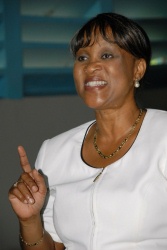Measure Jamaican Schools on Value Added -Educator urges
KINGSTON, Jamaica – Accomplished educator and lecturer at The University of the West Indies, Mona, Joan Spencer Ernandez, is warning against using students’ performance in external examinations as the only basis for comparing and branding schools.
Mrs. Spencer Ernandez was pointing particularly to the yearly school rankings published in the media, which positions high schools based on the quality of scores they receive in the annual Caribbean Secondary Education Certificate (CSEC) General Proficiency Examinations. She argues that to rank schools based on their performance in CSEC is unfair to upgraded high schools as often they face a range of challenges that are not common in traditional high schools.
Mrs. Spencer Ernandez raised her concerns during a series of literacy workshops held recently under the Centres of Excellence programme funded by The Victoria Mutual Building Society and the Jamaica National Building Society through their joint Mutual Building Societies Foundation (MBSF). The initiative, which was funded at cost of $100 million, seeks to improve the delivery of education in six rural-based high schools.

Joan Spencer Ernandez, Lecturer in Language and Literacy at the University of the West Indies, Mona.
“You can’t compare schools which are receiving students who are reading at the primer and pre-primer levels, and expect them to achieve the same number and quality of subjects five years later, as their peers who entered Grade 7 reading at or above the Grade 7 level. They are at a clear disadvantage!” Mrs. Ernandez argues.
The ranking of schools, based on their performance in the CSEC exams, has been a sore point for many educators over the years. Many of them contend that the disparity in resources available to traditional and upgraded high schools, and the quality of learners streamed into both categories of schools leave little on which to draw a comparison.
The records also show that students who are usually channeled into the upgraded schools do not perform as well as those channeled into the traditional high schools. In addition, the non-traditional schools are the ones that receive students through the Grade Nine Achieve Test (GNAT).
Mrs. Spencer Ernandez says many children entering Grade 7 at upgraded high schools need to be brought up to the required reading and numeracy levels before they can begin to access the content of the curriculum.
“What we need to measure, and compare if needs be, is the value that has been added at end of the child’s school tenure,” she says.
Her view point was supported by many school administrators and teachers from the six rural-based high schools, who insisted that their students’ scores should not be compared with those of students attending traditional high schools.
Principal of the Green Pond High School in St. James, Michael Ellis, underscores that in addition to the challenges with literacy and numeracy, the schools are also usually forced to deal with students who have serious behavioural challenges.
“Sometimes the students are almost adults by the time they get to us,” he affirms, pointing to the students received through GNAT. “And at that stage many of them are difficult to manage. I often spend up to 80 percent of my day treating with indiscipline!”
“We believe in adding value to the students,” he emphasises.
“You have to consider the value that has been added over the period of time. You must measure them based on the level at which they came into the schools and how they have been able to close or narrow that gap,” agrees Dawn Sewell Lawson, Assistant Programme Manager at the MBSF. She notes that this position has been supported by the Centres of Excellence since its inception.
“The Foundation adapted and introduced to the schools two indicators. These are Average Term Progress and Average Year Progress, and they are not just applied at the school level, but can be applied to subjects, classes, grades, examinations as well as teachers,” she said.
“These two indicators are very effective; they allow for monitoring of school performance way ahead of CSEC time; measuring value added on term and year bases so appropriate corrective actions can be taken and, they provide a neutral ground on which to do both internal and external comparisons”.
She explains that the added benefit of these two indicators is that the hard work of teachers, which produces incremental improvement in student performance, can be readily recognized. “It is hoped that these indicators will be adopted by all schools.”


